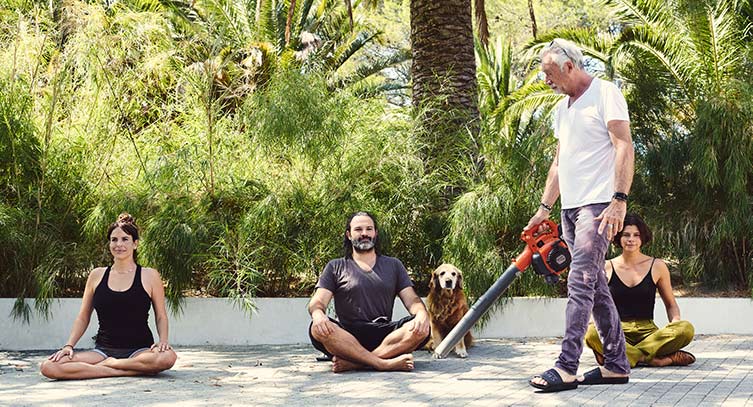Mindfulness of Sounds – Meditation Practice
Category: How to Meditate | Types of Meditation

What are meditation sounds? How to use sounds in mindfulness practice
Meditation is about paying attention in and to the present moment. But you’ve probably noticed that the present moment gives us lots of choices when it comes to what, in fact, we choose to pay attention to. The breath? Sensations? A mantra or phrase? Physical movement? How about sounds? As we practice meditation, sounds are bound to be part of the experience. There are peaceful meditation sounds and unwelcome ambient sounds. There’s meditation music with nature sounds and there are annoying barking dog next door sounds.
Broadly speaking, there are two main kinds of sounds in meditation: those we deliberately choose to enhance our focus or relaxation, and those we have to deal with because we’re powerless to stop them. Let’s look at how we can work both kinds into our meditation practice.
Sounds to meditate to
Nature
If you’re able to practice outdoors, you can choose to focus your awareness on sounds in the environment. You may find it very enjoyable and replenishing to settle into the present moment while paying close attention to nature sounds. For meditation, the goal is to notice sounds without getting caught up in identifying or assessing them. You’re not trying to discern whether that birdsong belongs to a robin or a scarlet tanager. Instead, simply relax into noticing and letting go, noticing and letting go as a form of mindfulness meditation where nature sounds are a powerful ally.
Mantras
A number of spiritual traditions use mantras or repetitive phrases as a means to develop inner qualities or deepen connections with a higher power. There are many different forms of mantra recitation; the one that will work best for you is the one that’s most closely aligned with your intention. Whether you’re reciting or chanting your phrase out loud, or focusing on it as an unspoken inner sound, meditation benefits develop as your practice becomes more familiar.
Guided meditations
A widespread form of sound meditation, guided meditations use the sounds of another person’s voice to take the guesswork out of practice. Three popular forms of guided meditation are mindfulness, stress reduction and relaxation. Some deep sound meditations use voice as well as background melodies to enhance the relaxing or mesmerizing effects of the practice.
Meditation sounds for sleep and healing
Another way to make use of sound, healing meditations and repetitive sounds for sleep—think gentle waves on a beach or babbling brooks, for example—have a therapeutic purpose. Some of these recordings are very soothing and conducive to deep relaxation. While such meditations have a different flavor than more traditional forms such as mindfulness and awareness practices, they do require the listener to pay attention and settle the mind on the sounds provided if they are to be truly effective.
Working with annoying sounds during meditation
If you’re lucky enough to be able to practice regularly in a tranquil and welcoming space, more power to you. But for most of us (unless we’re in retreat), life is noisy. Even when you have the house to yourself and you’ve silenced the phone, all sorts of things can conspire to disturb your mindful moment. Street noises. Airplanes. The neighbor’s dogs, donkeys or roosters. Leaf blowers. A mouse scratching in your sock drawer. The fridge. Sirens.
In fact, when the mind is paying full attention to one thing, it’s less likely to notice or be disturbed by another. For example, if you’re fully engrossed in an activity such as reading, music, games or exercise, you can happily ignore what’s going on around you. When you engage in meditation, on the other hand, it can feel as if the mind finds itself with so much space that it notices every little itch, thought and sound. Rest assured that with practice, the mind learns that it can perceive such happenings without being distracted by them. We’re back to training in noticing, letting go, and coming back to the breath or other meditation support.
In Asia, there are advanced meditators who place themselves in particularly noisy, agitated surroundings in order to test the stability of their practice. We heard about a yogi who would meditate on a mat in the middle of a busy platform in a bustling, crowded train station in India. These stations are notoriously hectic and chock full of distractions. Apparently, the yogi was able to continue his practice without a hiccup while porters, passengers, tea sellers and food hawkers went about their frenzied business. He was living proof that even if the circumstances aren’t what we’d consider ideal, it’s still possible to be mindful and practice meditation once you’ve got the hang of it.
Ambient sound meditation
If you’re a beginning meditator, though, you may not be ready to practice in Grand Central Station; you don’t want every sit to be an exercise in frustration. If ambient sounds are making it difficult for you to enjoy practice, consider investing in a pair of noise-canceling headphones. As your practice deepens, you’ll be better able to accept sounds and other sensory stimuli with greater equanimity. You can choose to use sounds—any sound that you’re aware of—as the basis for your practice, just as in the nature sounds meditation above.
Every time you’re conscious of a sound—rumbly tummy, airplanes overhead, cat scratching in the litter box, whatever—simply rest in the awareness of it. Allow the sound to come, go or stay. You can do this meditation for short periods during mindfulness practice or devote a session to it.
There are bound to be noises that we don’t like. And it isn’t because we don’t like them that they’re going to go away. Thanks to our meditation, we’re learning that we can acknowledge sounds without judging or being swept away by them. It’s exactly the same as with thoughts, emotions and physical sensations. Our practice is teaching us that we actually have choices when it comes to what we pay attention to, react to and elaborate on. The understanding that’s based on our meditation experiences is applicable in everyday life: we have choices, and we’re learning to choose wisely. Once we’ve realized the power of this, we can go ahead and thank the leaf blower, barking dog and sirens for giving us yet another opportunity to practice.






